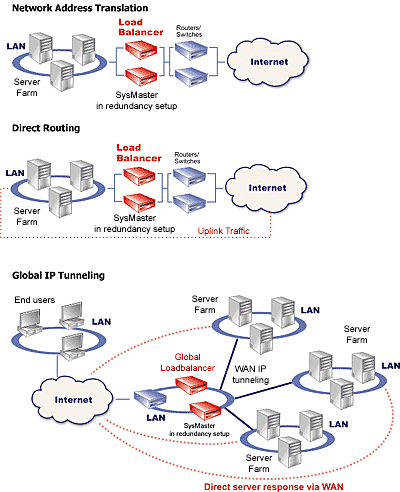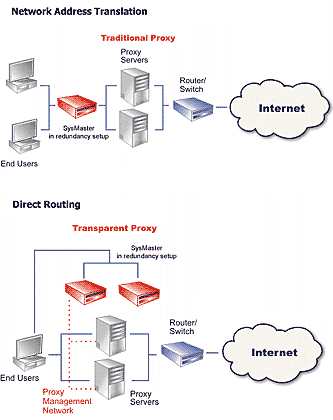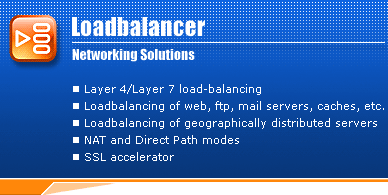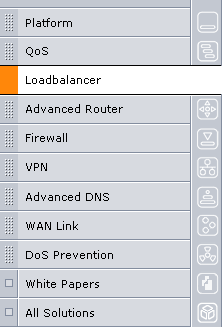|
LOADBALANCING AT LAYER 4
  |
Loadbalancing Server Clusters |
 |
 |
 |
Loadbalancing server clusters is a basic SysMaster
function module. Enterprise network administrators can choose from
several scheduling and packet forwarding methods to receive the
best performance results of their hardware. SysMaster provides high
availability and increased reliability for Internet services running
on SysMaster network solutions.

Clients send requests to a Virtual
Service managed by SysMaster. SysMaster analyzes the load of the
servers in the server farm, and forwards the request to the least-loaded
Real Server. The server processes the request and sends the reply
directly to the client.
Since SysMaster takes into account the individual
capabilities of every server, you can put servers with varying capabilities
in one cluster, obtaining optimum performance and high utilization
of the available resources, and thus reducing future investment
costs.
Direct-Path Routing mode for High Speed Loadbalancing
To increase the overall throughput of the server cluster, SysMaster
implements the Direct-Path Routing technique allowing servers to
send responses directly to the clients without passing through the
loadbalancing device.
NAT Loadbalancing
The NAT feature allows for higher security of the internal networks
because all servers in the cluster are not directly visible on the
Internet due to the network address translation procedure taking
place at the SysMaster device.
  |
Loadbalancing Globally Distributed
Server Clusters |
 |
 |
 |
Global Scalability and Availability (IP Tunneling)
The unique architecture of SysMaster allows loadbalancing
to be performed on both a local and global basis. Utilizing the
Global IP Tunneling feature of SysMaster, real servers can be geographically
distributed, maintaining uninterruptible service even when site-wide
failure occurs.
  |
Loadbalancing Network Caches |
 |
 |
 |
Companies use network proxy caches to improve Internet
performance for internal users and reduce uplink bandwidth usage.
Users access the Internet through the proxy cache server that stores
frequently requested content. Instead of retrieving the information
from the Internet, users use the locally stored content. SysMaster
optimizes performance of proxy cache servers providing the quickest
possible response to the clients.
SysMaster loadbalances user requests to the cache
server best able to process the requests. If the requested data
is not available locally, the Proxy server retrieves it from the
Internet, and then redirects it to the end user that requested it.
The whole process remains totally transparent to the end user. SysMaster
facilitates this process by efficiently decreasing the latency time
from requesting Internet content to actually receiving it.

Internal users request content from
the Internet. SysMaster loadbalances user requests to the cache
server best able to process the requests. If the requested data
is not available locally, the Proxy server fetches it from the Internet.
If the data is available locally, or when it comes from the Internet,
it is delivered directly to the client. The whole process remains
totally invisible to the end user.
Persistence
SysMaster integrates another feature allowing web users to resume
their connection to same server they communicated with initially.
SysMaster offers two modes of persistence: Source-Server
and Mega Proxy Server.
Setting up IP Pools
With SysMaster, administrators are able to configure a pool of IP
addresses that will be mapped to a single real server from the cluster.
  |
Loadbalancing Technology Features
of SysMaster |
 |
 |
 |
Advanced Flexibility - Huge variety of balanced
traffic
SysMaster supports the following IP Protocols:
Web (http), FTP, UDP, DNS, E-Mail, LDAP, TCP,
SSL, Streaming Audio, Streaming Video and others.
SysMaster allows for loadbalancing a vast number
of different types of network devices:
Internet servers, Firewalls, Routers, Cache servers, Proxy servers,
Multimedia servers, VPN, NFS and LDAP servers, and others.
High Scalability
SysMaster offers exceptional scalability.
Server Level Scalability - Additional servers
can be added to the cluster on the fly, or they can be taken out
of service for upgrade or maintenance without affecting the quality
of service (QoS).
Traffic Level Scalability - When web traffic
increases, you can easily add another server to the cluster to
achieve the necessary performance gain instead of upgrading expensive
hardware. This way, your web site infrastructure can easily grow
as the demand for its services increases, while protecting the
investments made in the existing servers.
Platform Level Scalability - Can be used
with multiple heterogeneous hardware platforms, allowing organizations
to protect their investments in their legacy hardware installations,
as well as integrate future hardware investments.
Multiple Load Balancing Methods
SysMaster provides a comprehensive choice of loadbalancing algorithms,
as well as multiple modes for different VIP groups, that enables
an organization to choose a configuration that best meets its needs:
Static Modes
Round Robin - Distributes connections evenly across the
servers it is managing, passing connections to the next one in
line;
Weighted Round Robin - The Weighted Round Robin algorithm
treats the servers of different processing capacities. Each server
can be assigned a weight, an integer value that indicates the
processing capacity.
Dynamic Modes
Least Connections - Sends new connections to the server
with least number of current connections.
Weighted Least Connections - In this mode, the servers
with a higher weight value will receive a larger percentage of
live connections at any one time;
Optimized Weighted Round Robin - Similar to the Weighted
Round Robin algorithm with the addition that each server can be
dynamically assigned a weight depending on its current availability
and current load;
Optimized Weighted Least Connections - Similar again to
the Weighted Round Robin algorithm, but all weights are calculated
dynamically to represent the current responsiveness of the servers
in the managed server array.
Rate Shaping
SysMaster can be used to assign different priority to specific
connections to provide for high level of QoS.
Security
SysMaster has an inherently high level of security
because using it, administrators can build high performance server
arrays that can failover easily. This is a much more viable and
scalable solution than using only one or two powerful but expensive
servers whose failure can be critical.
Persistence
SysMaster integrates another feature allowing your
users to resume their connection to the server they communicated
with. SysMaster offers two modes of persistence: Source-Server
and Mega Proxy Sever Persistence - Big enterprises
and ISPs use loadbalancing across multiple proxy servers to connect
to the Internet.
High Speed
Direct-Path Routing Performance
SysMaster includes a loadbalancing mode called Direct-Path Routing.
This mode allows servers to bypass SysMaster when returning traffic
to the client. This method allows for supporting an increased number
of simultaneous connections that translates to greater throughput
of your services as a whole.
Easy Performance Upgrades
Internet traffic demands are advancing rapidly.
The SysMaster is ready, thanks to its unique hardware/software design
allowing organizations to receive performance gains without having
to upgrade to expensive hardware.
|





